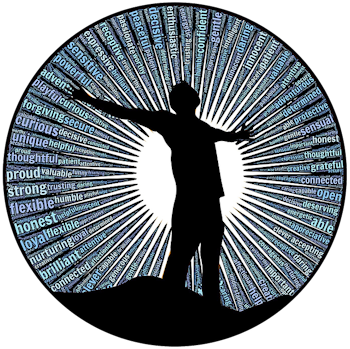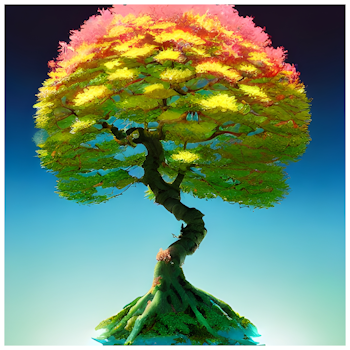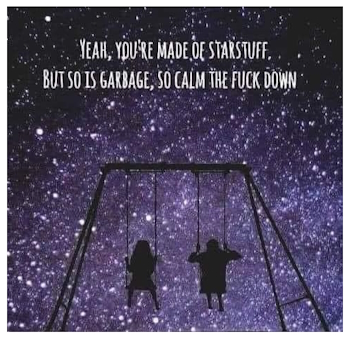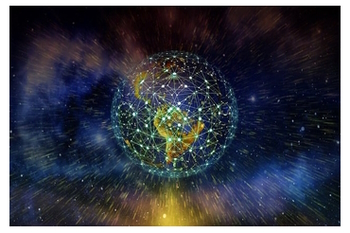
There are some topics I’ve been writing about that people may not realize are connected, but they are. When I wrote about how we humans, we algorithms are doing bonsai on ourselves and artificial intelligences, it was not just happenstance.
We are a medium. Just one on the planet, but we are a medium, built upon a medium of a planet, and we’re building other mediums even while we interact in increasingly positive ways with other mediums as we grow to understand them.
The medium is the message.
Marshall McLuhan, Understanding Media : The Extensions of Man (1964)
This is important to understand. Regardless of how you believe this world came into being, we all should know by now about DNA and how we recognize that other living creatures also have DNA. Some of it is close to matching ours, but the results are different to us.
We’re a 96% match to chimpanzees, and I’m fairly certain chimpanzees know we’re very different from them in many ways.
Our DNA varies within our species as well, with what we call recessive and dominant genes and all their complexity of impacting everything from hair color to deciding whether our big toe is dominant on our feet or not.

We have social attributes, which could also be seen as mediums since they too are canvases upon we decorate our pieces of time. Language, culture, religion (or lack thereof) are some of the substrates upon which we grow our own mediums.
We aren’t just surrounded by information. We are information. We are history without words, a strand of our DNA tells us the path we traversed through time to get where we are.
It doesn’t tell us why we traversed the particular path we got here by. That’s for the archaeologists and others to piece together from fragments of physical history.

We are our own bonsai, where our trunk and branches show where we have grown from – the trail through time and the history of how we got where we are.
Each one of us, as an individual, has our own root system, our own trunk, our own branches. Each one of us is both medium and message, impacting our societal medium and message, all part of a planetary ecosystem of mediums and messages.
Everything we see has information, from the tree outside that has evolved over millions of years to that one specimen, to the street which follows a path dictated by many human variables.
If we stand back and look at our planet, allowing ourselves to fade into the background, we’re not too far of Douglas Adams‘ allegory of the Earth being a computer designed to figure out the meaning of life. In fact, many people who have read Douglas Adams don’t necessarily understand how true it is.

It’s sort of like the Gaia hypothesis, though there are issues with mixing metaphor with mechanism, among other things. Popular thought on evolution ascribes intentionality to evolution, as if there were some guide to it all, but adaptation to survive is quite possibly the only intention.
We tend to ascribe intention and look for intention where there may be none. Intention makes us feel more comfortable, but it isn’t necessarily true.
“This is rather as if you imagine a puddle waking up one morning and thinking, ‘This is an interesting world I find myself in — an interesting hole I find myself in — fits me rather neatly, doesn’t it? In fact it fits me staggeringly well, must have been made to have me in it!’ This is such a powerful idea that as the sun rises in the sky and the air heats up and as, gradually, the puddle gets smaller and smaller, frantically hanging on to the notion that everything’s going to be alright, because this world was meant to have him in it, was built to have him in it; so the moment he disappears catches him rather by surprise. I think this may be something we need to be on the watch out for.”
Douglas Adams, The Salmon of Doubt (2002)
We tend to think ourselves the center of our universe of existence, and we often treat ourselves as the North Star of the planet. This is likely natural; everything we know, every bit of information we process, comes to us through our senses.

Although the medium is the message, the controls go beyond programming. The restraints are always directed to the “content,” which is always another medium. The content of the press is literary statement, as the content of the book is speech, and the content of the movie is the novel. So the effects of radio are quite independent of its programming.
Marshall McLuhan, Understanding Media (1964)
This is why McLuhan balanced what he said in his over-used quote, “The medium is the message” with what was the technological equivalent of machine learning of his time: Radio.
Radio connected a world over distances previously daunting during that period, and while mostly a broadcast medium then, his focus needs to be understood.
Communication has evolved long beyond that in a little over half a century. ‘Programming’, now thanks to Web 2.0, is a matter of choosing people’s social media messages so they build their own narratives. Web 2.0 provided us the illusion of choice.
The medium was the message, the message became medium, the media became the message, and so on.
We forget that we, too, are medium, though we don’t altogether understand the message and maybe we’re in the process of finding out what that is.
It gets deeper, too, but I’ll leave you with one more quotation from McLuhan, who happened to say and write quite a few things that continue to make sense to this day.
Media are means of extending and enlarging our organic sense lives into our environment.
Marshall McLuhan, “The Care and Feeding of Communication Innovation”, Dinner Address to Conference on 8 mm Sound Film and Education, Teachers College, Columbia University, 8 November 1961.
